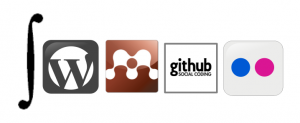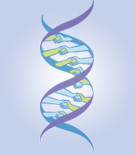Disclaimer: Not a Blog
 Welcome to my open lab notebook. This is the active, permanent record of all my scientific research, standing in place of the traditional bound lab notebook. It is a record of ideas, and intuitions; results and mistakes. Please bear in mind that the notebook is primarily a tool for me to do science, not communicate it. I write my entries with the hope that they are intelligible to my future self; and maybe intelligible to my collaborators and experts in my field. This is not a research blog, where each entry can be read alone and understood by a general audience in an edited and polished form. ((Okay, with the exception of those items posted in my Open Notebook Science category, which is more like a blog. These entries still include me experimenting with methods, tools and ideas, but are written with more of an audience in mind.))
Welcome to my open lab notebook. This is the active, permanent record of all my scientific research, standing in place of the traditional bound lab notebook. It is a record of ideas, and intuitions; results and mistakes. Please bear in mind that the notebook is primarily a tool for me to do science, not communicate it. I write my entries with the hope that they are intelligible to my future self; and maybe intelligible to my collaborators and experts in my field. This is not a research blog, where each entry can be read alone and understood by a general audience in an edited and polished form. ((Okay, with the exception of those items posted in my Open Notebook Science category, which is more like a blog. These entries still include me experimenting with methods, tools and ideas, but are written with more of an audience in mind.))
Philosophy: Why an open notebook?
So you’ve probably noticed this lab notebook is openly accessible, you can read it online without passwords or permissions. And if you’ve read the disclaimer at the top you’ve gathered that it isn’t written for you, it’s written for me. So why is it open? What does that mean anyway?
This icon, also on the bottom of my  webpage indicates that I make my best effort to make all content (AC) available as I go. Other models involve some private results or information released only after some delay. These different icons are used across the scientific community to identify Open Notebook Science (ONS). The other icon at the bottom of each page is the Creative Commons license. In addition to being openly visible, anything in this notebook can be reused and reproduced under the terms of this license.
webpage indicates that I make my best effort to make all content (AC) available as I go. Other models involve some private results or information released only after some delay. These different icons are used across the scientific community to identify Open Notebook Science (ONS). The other icon at the bottom of each page is the Creative Commons license. In addition to being openly visible, anything in this notebook can be reused and reproduced under the terms of this license.
Researchers have found many reasons for making their notebook open: better collaborations, greater visibility and broader impact for funding requirements, sharing detailed methods, solving the dilemma of null results publishing, helping other scientists advance, demonstrating the viability of the idea or participation in a community of open science. For myself, I decided to try ONS as an experiment. As I go along, I record reflections about the experience in my notebook, so it has gotten a category alongside my scientific research topics. Follow along and see how the experiment works out.
An Integrated Notebook

In these pages you will find not only thoughts and ideas, but references to the literature I read, the codes or manuscripts I write, derivations I scribble and graphs I create. I see my notebook as consisting not only of the entries here (in Wordpress), but the databases for articles, code and images that are embedded or linked from the notebook to external repositories. (Mendeley, Github, Flickr).
Lab Notebook: Wordpress
I make daily entries in the lab notebook using Wordpress blog support. I describe my objectives, progress and results The notebook documents everything I would need to repeat my analysis. I also record my notes from seminars, feedback from meetings, and outlines for talks and manuscripts. My codes, my figures and the literature with my notes are all stored in external repositories and linked into my daily entries, keeping entries complete but compact. The notebook supports links, reader comments, tags, timestamps, and full text search.
Literature Database: Mendeley
Whenever I read an article, I add the pdf to my Mendeley collection, a reference database. Within the database I can add comments and notation to the article, and use it to insert citations to articles into my daily notebook entries. I can also share the annotations with collaborators, who can add their own comments and also add articles I should be aware of to the collection.
Code database: Github
My actual work more often involves writing software, exploring simulations, performing data analysis or writing manuscripts or presentations – i.e. writing and revising text/code. These changes are committed to Github with a comment in the log summarizing the update. Despite continual revisions, the snapshot of any code or revision from any day can be recovered by the link directly from the lab notebook.
Image Database: Flickr
Some kind of graphs or figures are the most common output of any code or exploration I do. For calculations which I’ve worked out on a chalkboard or scratch paper it’s much faster to photograph than to type. Any simulation or analysis I run automatically adds the resulting figures with appropriate tags and description to my Flickr database. The description points to the version of the code (on Github) that can reproduce it. I can then embed particular results individually into a daily entry or add complete sets of images using a scrolling gallery.
Organization & Navigation
Clicking on Lab Notebook on the top menu bar displays of my most recent notebook entries. Each entry is given assigned a category corresponding to the research project (currently Comparative Phylogenetics, Stochastic Population Dynamics, and Adaptive Dynamics), or entry type (my Teaching journal, Open Notebook Science thoughts and tools, notes from Seminars.)
The footer of my webpage provides the navigation controls. The calendar links to all entries on a selected date. There’s also a category tree and full search. Entries also have tags.
All of the other databases reflect the project categories: My Flickr tags (“phylogenetics”, “stochpop” and “adaptivedynamics”), Mendeley Public groups (“Phylogenetic Methods”, “Theoretical Ecology”, and “Adaptive Dynamics”), and Github repositories (“Comparative-Phylogenetics" and “structured-populations“,”AdapitveDynamics“). The articles, images, or code in each database have stable urls to link to, and each database provides additional tags/groups/repositories for finer categorization, as well as search capability.
The Social Lab Notebook
The services I integrate into  my notebook aren’t just relational databases. They are also all social networking platforms built around a particular type of data (blog entries, publications, images, code). All have RSS feeds that let them live-update each other. All (except Wordpress) have a notion of contacts and social graph.
my notebook aren’t just relational databases. They are also all social networking platforms built around a particular type of data (blog entries, publications, images, code). All have RSS feeds that let them live-update each other. All (except Wordpress) have a notion of contacts and social graph.
All have mobile applications, a developer API so anyone can extend them, a large user base, and provide a cost-free service. In addition to integrating with the notebook, they provide their own sophisticated interface to their content.
At the hazard of coining a new acronym, I consider this makes it a “Social Lab Notebook.” An Electronic Lab Notebook brings many advantages over its paper predecessors. I feel that making it an Open Lab Notebook adds to this the potential benefits of Open Science, while a Social Lab Notebook leverages these content-driven social networks to help achieve them.
Without additional effort, I simultaneously contribute to the rapidly growing database of curated literature, reusable scientific images and a repository of open-source scientific code. These objects rub shoulders with similar content in these broad-use databases, where they are more discoverable and reusable. Data finds data, then people find people. As more scientists use these tools, the more powerful they become.
A bit of history
I originally became interested in the concept of Open Notebook Science through reading about the open notebook of Cameron Neylon, and later also the groups of Jean-Claude Bradley andSteve Koch. I was later featured in Science Careers for a piece on open notebook science.
 I began my experiment in ONS on the wiki-based platform OpenWetWare. With a tool to create a notebook template and an established community of researchers with such notebooks (also sharing course content, experimental protocols, lab webpages, etc) it provided an excellent introduction. I was swiftly contacted by established PIs offering encouragement, advice and even collaboration. My original notebooks remain there, with future entries connected from this site automatically through the Category feed. Limitations in my ability to customize, control and extend OWW mediawiki platform have led me to migrate to my own independently hosted site and domain here.
I began my experiment in ONS on the wiki-based platform OpenWetWare. With a tool to create a notebook template and an established community of researchers with such notebooks (also sharing course content, experimental protocols, lab webpages, etc) it provided an excellent introduction. I was swiftly contacted by established PIs offering encouragement, advice and even collaboration. My original notebooks remain there, with future entries connected from this site automatically through the Category feed. Limitations in my ability to customize, control and extend OWW mediawiki platform have led me to migrate to my own independently hosted site and domain here.
Other resources
Many others have assembled excellent collections, advice and resources on ONS. I only point in the way of several that most influence me.
FriendFeed’s (FF) Science2.0: I believe this is still the best place to ask a question about ONS, and its popular threads cover the major questions and latest news in the practice. Most of the visionaries and experts in Open Science and online tools for science can be found here. Thanks to so many of you there (and on FF Life Sciences) who have helped me along!
Hmm, I don’t seem to be able to think of anything that wasn’t also discussed on FF.